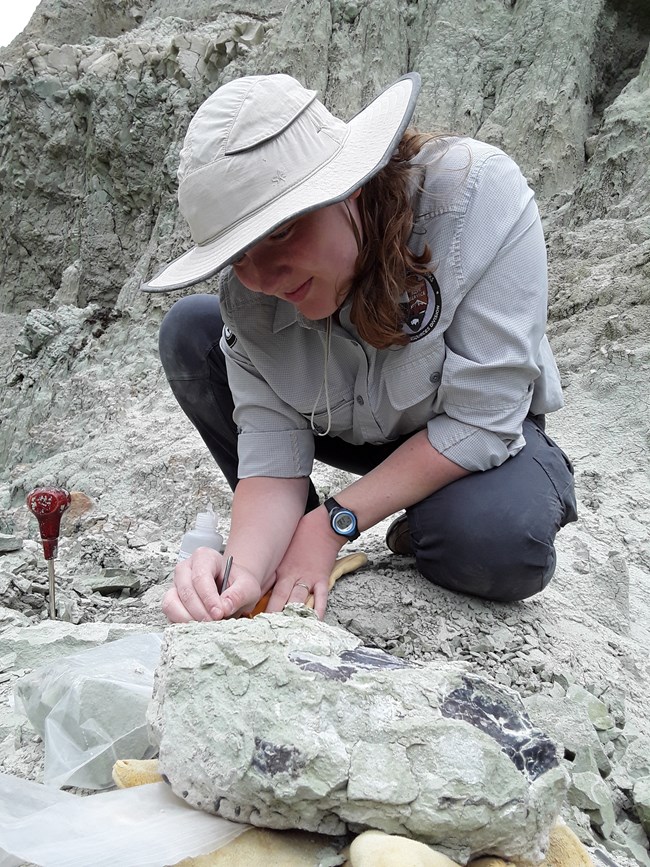Part of a series of articles titled Using Science to Preserve the Past.
Article
Using GIS Data to Improve Fossil Collection Practices at John Day Fossil Beds National Monument

NPS
John Day Fossil Beds National Monument protects geologic formations that contain one of the longest, most continuous fossil records on Earth. Early dogs and horses, false saber-toothed cats, and the last known primate in North America are among the discoveries paleontologists have made in these formations. Many more incredible finds surely await. Part of the park’s mission is to keep learning about tens of millions of years of the region’s history through ongoing fossil collection. But what is the best way for limited paleontological staff to go about collecting fossils from 22 square miles of parkland, plus neighboring park partner fossil beds?
After its 1975 founding, the park switched away from sporadic university expeditions to consistent fieldwork by park staff. Staff were scheduled to prospect for fossils in each of the five most productive areas, every four years. The idea of this cyclical schedule was to allow enough time for erosion to uncover more fossils without waiting so long that significant discoveries eroded away. Yet the productive areas were large, and staff availability varied seasonally and year to year. Staff were almost never able to stick to the schedule. Instead, they aimed to collect as many significant or identifiable fossils as possible. That meant focusing on the rock layer that has the most fossils, even though the park contains many rock layers of many different ages. As a result, Anne Kort, a Geoscientists-in-the-Parks intern tasked with digitizing fossil location information, started to wonder: was a four-year cycle really a good goal?
To find out, she and her supervisor, park Chief of Paleontology Dr. Nick Famoso, decided to take a closer look at the last 30+ years of field work. Specifically, Anne wanted to know how many samples were collected where over that time. But before she could analyze that data, she needed to finish digitizing it. Early on, location data was recorded by measuring down and across a physical aerial photograph. Then, when handheld GPS units became available, GPS coordinates were recorded on paper. It wasn’t until 2017 that coordinate collection at the park became fully digital, so the digitization process was no small task. Yet it was totally worth it.
To their surprise, the scientists found that it did not matter whether paleontologists searched for fossils at a site every year, or every two, three, four, or 5+ years. They would still find similar numbers of specimens. At least in the most productive Turtle Cove Member, a single year of erosion was enough both to expose new fossils, and to re-bury uncollected ones. In other words, even in the best staffing scenarios, there are so many fossils at John Day that it will never be possible to find them all.
Given their findings, the scientists propose a new, more flexible monitoring scheme. At the heart of the plan is their newly created geodatabase of past collection locality data. It allows users to see all collection areas at a glance, track specimens needing excavation/extraction, and add new collection information as it becomes available. With such data at their fingertips, staff can set fieldwork priorities annually, taking into account existing obligations and staff availability. Also informing annual priorities will be a set of guidelines inspired by the original cyclical schedule. These will help limit collection biases and ensure fieldwork is more evenly distributed among the different rock layers.
The John Day scientists’ research, recently published in Palaeontologia Electronica, also has implications for other field programs with long-term locality data. For example, digitizing and analyzing locality data, and tracking new GIS information in real time, can lead to valuable re-assessments of long-standing fieldwork assumptions. Not to mention new and improved future fieldwork plans!
For more information
Kort, Anne E. and Famoso, Nicholas A. 2020. Novel analysis of locality data can inform better inventory and monitoring practices for paleontological resources at John Day Fossil Beds National Monument, Oregon, USA. Palaeontologia Electronica, 23(1):a17. https://doi.org/10.26879/1053
Last updated: March 10, 2021
